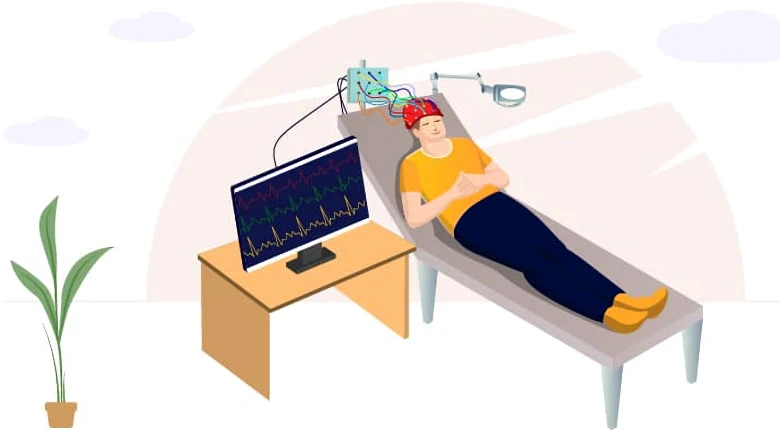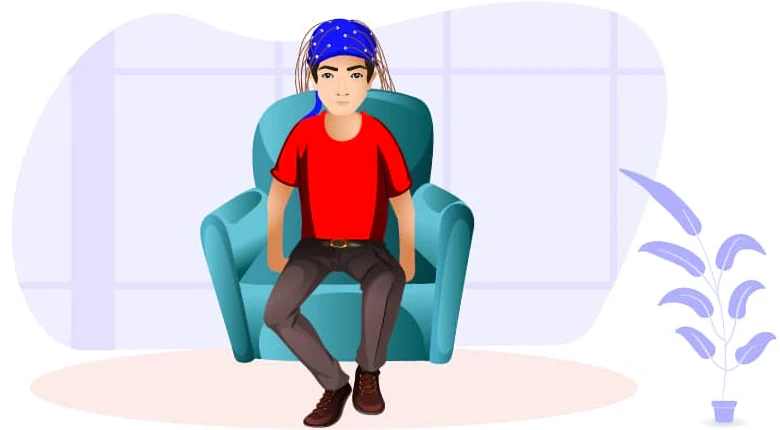NEUROFEEDBACK

WHAT IS NEUROFEEDBACK?
Neurofeedback improves self-regulation by using advanced algorithms to analyze brain activity and provide real-time feedback to the individual. This feedback is delivered through visual or auditory cues and is designed to guide the brain towards desired patterns of activity. By rewarding the target brain wave patterns and ignoring the undesirable patterns, the brain learns to adapt and improve its own function.
One of the key advantages of neurofeedback is that it is non-invasive and utilizes the brain’s own capacity for neuroplasticity to make positive changes. This makes it a safe and effective alternative to traditional therapy methods. Additionally, the use of advanced QEEG technology allows for a highly precise and accurate measurement of brain activity, providing a deeper understanding of the underlying causes of a wide range of mental and physical disorders.
The goal of neurofeedback is to transform an unhealthy, dysregulated brainwave pattern into a normal, healthy, organized pattern. By doing this, the brain becomes more stable and is able to operate optimally and efficiently. When your brain is better regulated, it allows you to change behaviors and thoughts.
Neurofeedback is a cutting-edge technology that utilizes real-time displays of electroencephalography (EEG) to train the brain to regulate functions of the body and mind. It is an operant conditioning tool that re-trains the dysregulated brain to behave in a more normal and optimal way. By using sensors placed on the scalp to measure brain waves, neurofeedback can identify patterns that are not functioning optimally, and then provide real-time feedback to the individual, allowing them to adjust their brain waves to a more desirable pattern.
By rewarding brain activity that fall into desired patterns, and ignoring those that don’t, the brain learns to adapt to the rewards and develop new healthy patterns. This process is non-invasive, and instead of trying to affect the body from the outside, it helps the brain to deal with problems at the foundation, leveraging the brain’s own ability to learn and adapt.
The goal of neurofeedback is to transform unhealthy, dysregulated brainwave patterns into normal, healthy, organized patterns. This allows the brain to become more stable and operate optimally, leading to improved behaviors and thoughts.
Neurofeedback is considered by the FDA (Food and Drug Administration) to be safe and has been supported by numerous studies, showing its efficacy in treating various conditions such as ADHD, anxiety, depression, and PTSD.
BRAIN REGULATION
The human brain is a marvel of biological engineering, possessing the remarkable ability to adapt and respond to changes occurring within the body and the external environment. This adaptability ensures that the brain is able to function effectively and efficiently under a wide range of conditions.
However, it’s important to note that this finely tuned system can sometimes be thrown off balance. Genetic predispositions and environmental influences can lead to a state of ‘dysregulation’ in the brain. In this dysregulated state, the brain may become over-stimulated when it should be in a state of calm, or conversely, it may be under-stimulated when alertness and attention are required. This can lead to a variety of issues, including difficulty focusing, restlessness, and other cognitive challenges.
Despite these potential disruptions, the brain is not without its own self-correcting mechanisms. There are instances where the brain can recalibrate itself, working towards restoring its normal functioning. However, this is not always possible or sufficient, and in such cases, external intervention may be necessary.
Neurofeedback emerges as a powerful tool in this context, offering a pathway to steer the brain back towards a state of normal functioning. This technique is centered around instructing the brain to self-regulate, thereby enhancing its capacity to react suitably to a variety of situations and stimuli. The core idea is to empower the brain to self-correct and self-regulate, which in turn fosters resilience and bolsters overall cognitive health.



HOW DOES NEUROFEEDBACK WORK ?
Before beginning training sessions, a comprehensive assessment using Quantitative Electroencephalogram (qEEG) is conducted to determine if a client’s brainwave patterns deviate from normal in a scientifically objective manner. This assessment procedure allows the therapist and technician to identify any areas of the brain that may be functioning outside of the typical range and to tailor the training sessions to address these specific areas.
The assessment results are used to create tailored neurofeedback training protocols that aim to retrain the brain activity towards normal, leading to more optimal and efficient brain function. These protocols are designed to target specific areas of the brain that have been identified as deviating from normal, and to help the brain learn to regulate itself in these areas.
During the training sessions, the individual is connected to a computer using noninvasive sensors that record brainwave activity. These sensors are placed on the scalp and do not involve the use of any electrical current. They simply record the brainwaves coming from the brain and transmit this information to the computer. The information about these brainwaves is displayed on the therapist’s monitor, allowing the therapist to track the patient’s progress and adjust the training protocols as necessary.
The software used in the neurofeedback training automatically detects when the brainwaves are properly ordered and it feeds that information back to the patient. This feedback appears in the form of a game, movie, or sound, which signals the patient that the brainwaves are becoming more ordered. As long as the patient’s brainwaves are moving in an orderly direction, the reward is displayed and the patient hears a sound. If the brainwave patterns move away from an orderly pattern, then the picture dims or disappears and no sound is produced. The brain’s natural desire to watch the movie clearly will drive those neurological circuits that normalize the brainwaves and allow the picture to be visualized. The more those circuits are driven and used, the more neuroplasticity changes take hold. The client learns how to use those new circuits during the demands of everyday life.
This creates a feedback loop, where the patient can control the picture and sound with their brain, and in doing so, the brain is learning how to regulate itself.
At the Chiang Mai Neurofeedback Center, we use a 19-channel EEG/QEEG system called swLORETA (Standardized Weightened Low Resolution Brain Electromagnetic Tomography). swLORETA utilizes a 3D model of the brain to provide more detailed and specific information about brain activity. It is considered superior to traditional 2 or 4-channel neurofeedback training because it allows for more accurate and precise measurement of brain activity in specific regions. Additionally, swLORETA can be used to target specific areas of the brain that may be associated with certain conditions, whereas traditional neurofeedback techniques are more general in nature.

EEG (electroencephalograph)
An EEG, or electroencephalograph, is a non-invasive and painless test used to record the brain’s electrical activity, also known as brainwaves, at the surface of the scalp. Small sensors are placed on the scalp and detect the activity, which is then recorded for analysis. It’s similar to a heart monitor, which records your heart rate, but instead, it records the electrical activity of the brain.
The procedure typically takes around 30-60 minutes and the results can be obtained relatively quickly.
Overall, an EEG is an important tool for understanding the functioning of the brain and can provide valuable information for the assessment and training of neurological conditions and disorders.

QEEG (Quantitative electroencephalograph) – Brain Mapping
Brain mapping was introduced more than 30 years ago as a means to measure and diagnose brain function.
The QEEG brain map neurometrics readings give us vital information to help identify areas of over or under-activity to train, and to precisely chart your progress.
By seeing which areas have abnormal activity, we can predict what type of symptoms the person may be experiencing as a result and w know exactly where to train to help you regulate more efficiently. Symptoms can be accurately matched with brain locations (10/20 system and Brodmann Areas) and aberrant Z scores.
A QEEG can identify not only brainwaves, but also aberrant Z scores for absolute power, relative power, amplitude asymmetry, coherence (quality of communication between regions) and phase (thinking speed).
These are all crucial patterns involved in optimum mental functioning.
During neurofeedback session above values are evaluated real time and checked whether these patterns are typical or anomalous.
Linking your symptoms to brain activity is a crucial part of what we do. QEEG (Quantitative electroencephalograph) – Brain Mapping
A QEEG is a ‘state-of-mind test’ for the brain, providing an objective assessment of how your brain works.
The QEEG brain map gives us a 2-D & 3-D reconstruction of your brain activity in order to accurately target areas of your brain which are relevant for your goals or symptoms.
We use latest tools & Software (Neuroguide and LoRETA Neurometric QEEG Brain Mapping) for both our assessments and to track your progress over your neurofeedback sessions.



LoRETA (low resolution brain electromagnetic tomography)
Using the same equipment as approved for academic research, LoRETA allows us to identify (and ultimately train) brainwave patterns from deep brain structures, using a standard sensor cap with advanced source-correlation software.
Being able to identify and train these deeper structures in the brain is a major leap forward in both brain mapping and neurofeedback.
Z-SCORE DATABASE
We compare these brainwave readings to an FDA approved reference database (Z-score). We use this information as an aid to determine which areas to train in order to best meet your goals.
WHAT NEUROFEEDBACK CAN DO?
Restoring function to the brain by means of neurofeedback can alleviate a large variety of physical and emotional problems. Sleep patterns may improve, allowing increased alertness during the day.
Neurofeedback can reduce anxiety and depression as well as syndromes such as migraine or chronic pain. Hyperactivity, attention deficit, post-traumatic stress, and emotional instability are also frequently visible as abnormalities in the EEG and as such can be trained.
Neurofeedback training can also help with certain specific syndromes and issues, including traumatic brain injury, seizures, autism, and stroke cases. In these instances, the training may not eliminate the cause of the problem, but rather assists the brain to function normally despite the injury.
One of the technique’s great strengths is that it draws upon the brain’s own ability to learn and adapt.
Due in part to the nature of the training, neurofeedback training can help both children and adults. In fact, thanks to the innate flexibility of the growing child’s mind, it is especially effective for children.
Hyperactivity, attention deficit (ADD / ADHD), temper tantrums, and conduct problems are more often exhibited by children than by adults, and can be effectively trained. Furthermore, once the brain has learned to function normally, the effect is usually lasting, and relapse rarely occurs.
Because neurofeedback trains the brain to operate effectively, its applications are not limited to recovering from injury or coping with problems.
Neurofeedback training is also valuable to bring the brain back on track after day-to-day stress, or to facilitate peak performance, for example, for professional athletes or corporate executives.

WHY NEUROFEEDBACK?
Neurofeedback is a technique to train the brain to regulate functions of body and mind. When the brain is not functioning optimally, this is often reflected in mental or physical problems. Likewise, many cognitive, emotional, or bodily issues can be traced back to a poorly functioning brain.
Training your brain to improve its function can help it take better care of you, just like physical exercise can train your body.
Neurofeedback training is absolutely non-invasive, and rather than trying to affect the body from outside, it helps the brain to deal with any problems at the foundation, drawing upon the brain’s own ability to learn and adapt.
- The training has been achieved lasting results.
- Training results are at least long-lasting, often permanent, and continue to advance following training.
- The method is risk-free. It has no side effects.
- The process is painless
- Neurofeedback training can be combined with other therapies and treatments.
- Neurofeedback has been studied widely and long time.


